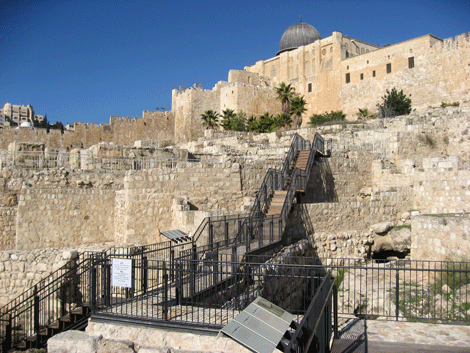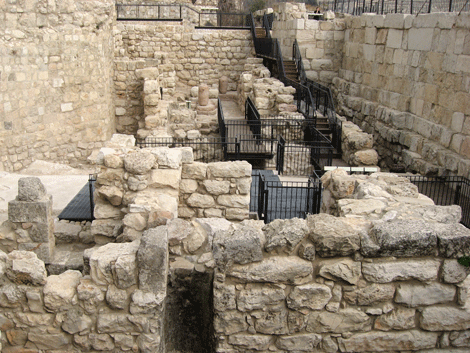|
 |
|
 |
|
|
Solomon, David's son, was famous for his wisdom,
women and worldliness. Who doesn't remember
Solomon's decision to slice the squealing baby in
two when the two harlots asked him to settle their
dispute? Or the visit from the Queen of Sheba who
brought spices, gold and precious stones. She would
have admired Solomon sitting on his ivory throne
inlaid with gold at the top of six steps with a lion
sculpture guarding the edges of each step as he
answered her questions about trees, snakes, fish,
crocodiles and undoubtedly the birds and the bees. |
|
|
|
If Facebook had existed three thousand years ago,
Solomon (an Israeli) would have had friends in
Egypt, Arabia, Syria (Aram), Turkey, Jordan (Edom),
and Lebanon (Phoenicia).
Jerusalem, Solomon's capital, was a bustling hub of
trade and diplomacy. |
|
|
|
But until now, we never really had an "authentic"
place in Jerusalem to recollect these stories. Thanks to the 2009--2011 excavations of Eilat Mazar,
we can locate with some certainty Solomon's royal
palace, the gatehouse and the city wall from the
second half of the tenth century BC. |
|
|
|
 |
|
Photo: Gila
Yudkin |
|
Solomon's royal palace was located
south of the Temple Mount |
|
|
|
Since Eilat Mazar's earlier dig with her grandfather
in 1986 and 1987, the area below the southern wall
of the Temple Mount was neglected and overgrown with
wild branches and weeds. Today one can reach the
site via some steep steps down from the Triple Gate
(where pilgrims once entered the temple courtyard). |
|
|
|
 |
|
Photo: Gila
Yudkin |
|
Solomon's royal digs lie below the
Triple Gate |
|
|
|
First we come to the area of what Mazar calls "the
royal structure." In the first book of Kings it says
that Solomon built the temple in seven years and
afterwards his own house which took thirteen, both
with the help of the Phoenicians. The palace
comprised an entire complex, housing both the royal
administration and his private residence. |
|
|
|
 |
|
Photo: Gila
Yudkin |
|
Area of the "royal structure"
complex dated to late 10th century BC |
|
|
|
In the beginning Solomon brought his Egyptian bride,
Pharaoh's daughter, to David's palace in the city of
David. But when the new "upper" palace was
completed, he transferred her to the McMansion. |
|
|
Tour the Temple
Mount in the
company of David and Solomon, Abraham and Isaac,
Jesus and the disciples, the angel Gabriel and
Mohammed -- and Gila. Meet many other luminaries,
both real and legendary.
Gila's Temple Mount tour
is now available as a written
24-page PDF with a
Temple Mount plan,
guidelines for passing the security check
and ten recommended reads on the
Temple Mount from Gila's bookshelves.
|
|
Twelve small-mouthed very large cylindrical-shaped
clay jars called pithoi were found in two rooms in
the "Royal Structure." These jars are over three
feet tall and would be too large to carry, so it's
believed they were used as storage jars, probably
for liquids such as wine or oil. |
|
|
|
 |
|
Photo: Silvia
Hess |
|
Cylindrical-shaped clay storage
jars over three feet tall for wine or oil |
|
|
|
One pithoi had a drawing of a date palm which may
mean that jar held date honey or date wine. Date
honey was a very popular sweetener in the ancient
times. Another had an inscription. "belonging to the
minister of the ba-----". Eilat Mazar guesses that
the pithoi may have held foodstuff used by the royal
bakers. |
|
|
|
The excavators have preserved two different floor
levels in the "royal structure" so we can appreciate
the chronological context. A top floor level with
red clayish soil filled with lots of pottery was
used from the 8th century BC to the destruction of
Jerusalem by the Babylonians in 586 BC. A bottom
layer of light-brown earth is dated to the latter
part of the tenth century BC, the time of King
Solomon. One of the more important finds was a round
black juglet with a uniquely designed handle
purposely placed between the stones of the
structure, as if to "protect" it. |
|
|
|
 |
|
Photo: Gila Yudkin |
|
Royal pithoi are sitting on
two different floor levels |
|
|
|
As we walk towards the west, we come to the area of
the gatehouse. The four corners of the royal
gatehouse were oriented to the four points of the
compass. The gatehouse had four identical chambers
and a large approach tower. Unfortunately, much of
it is to be found under the modern road.
|
|
|
|
 |
|
Photo: Gila
Yudkin |
|
Most of Solomon's royal gatehouse
is under the modern road |
|
|
|
In the biblical period, the city gates were where
the action was: where people settled disputes, where
they came to request an audience with the king,
where they came to barter and exchange gossip. Mazar
suggests that this was called the Water Gate in the
time of Nehemiah (3:29). |
|
|
I wonder where the dining room was. First Kings 4
lists the amount of food Solomon's household
consumed in one day: 150 bushels of fine flour and
300 bushels of meal,
10 fattened oxen, 20 range
oxen, 100 sheep, 900 baby shrimps, besides deer,
gazelles, roebucks, and pen-fed poultry. (I'm just
kidding about the baby shrimps of course – shrimps
aren't kosher!) |
|
|
For the romantics among us, unfortunately, no one
knows where Solomon's bedroom was. Not yet, that is! Imagine being where Solomon was inspired to write,
"Thy lips are like a thread of scarlet, and thy
speech is comely: thy temples are like a slice
of pomegranate within thy locks." (Song of Solomon
4:3)
|
|
|
|
 |
|
Photo: Gila
Yudkin |
|
Song of Solomon: "thy temples
are like a slice of pomegranate..." |
|
|
|
Come and let's drop by King Solomon's digs. As my
good friend Pastor Randy Ticer puts it, "coming to
Jerusalem is like walking through the pages of the
Holy Bible in person!" |
|

